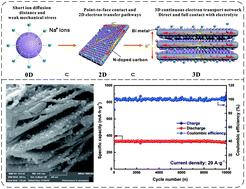Our official English website, www.x-mol.net, welcomes your
feedback! (Note: you will need to create a separate account there.)
A multi-layered composite assembly of Bi nanospheres anchored on nitrogen-doped carbon nanosheets for ultrastable sodium storage
Nanoscale ( IF 5.8 ) Pub Date : 2020-11-04 , DOI: 10.1039/d0nr07230c Xinxin Wang 1, 2, 3, 4 , Yang Wu 1, 2, 3, 4 , Peng Huang 1, 2, 3, 4 , Peng Chen 1, 2, 3, 4 , Zuyong Wang 1, 2, 3, 4 , Xiongwen Xu 4, 5, 6 , Jian Xie 4, 7, 8, 9, 10 , Ji Yan 4, 11, 12, 13 , Shuigen Li 4, 14, 15, 16 , Jian Tu 4, 5, 6 , Yuan-Li Ding 1, 2, 3, 4, 7
Nanoscale ( IF 5.8 ) Pub Date : 2020-11-04 , DOI: 10.1039/d0nr07230c Xinxin Wang 1, 2, 3, 4 , Yang Wu 1, 2, 3, 4 , Peng Huang 1, 2, 3, 4 , Peng Chen 1, 2, 3, 4 , Zuyong Wang 1, 2, 3, 4 , Xiongwen Xu 4, 5, 6 , Jian Xie 4, 7, 8, 9, 10 , Ji Yan 4, 11, 12, 13 , Shuigen Li 4, 14, 15, 16 , Jian Tu 4, 5, 6 , Yuan-Li Ding 1, 2, 3, 4, 7
Affiliation

|
Bismuth (Bi) is a promising anode candidate for sodium ion batteries (SIBs) with a high volumetric capacity (3765 mA h cm−3) and moderate working potential but suffers from large volume change (ca. 250%) during the sodiation/desodiation process, resulting in pulverization of the electrode, electrical contact loss, excessive accumulation of solid electrolyte interfaces, etc., devastating the cycling stability of the electrode seriously. Addressing this issue significantly relies on rational micro- and nano-structuring. Herein, we prepared a 3D multi-layered composite assembly of Bi/carbon heterojunctions with 0D bismuth nanospheres distributed and anchored on 2D nitrogen-doped carbon nanosheets (NCSs), using a preorganization strategy by taking full advantage of the strong complexation ability of Bi3+. The multi-layered composite assembly is periodic and close-packed, with Bi nanospheres <25 nm, carbon nanosheets ∼30 nm, and an average interlayer space of ∼75 nm. Such a specific architecture provides abundant electrochemically active surfaces and ion migration channels as the Bi nanospheres are attached to the 2D nitrogen-doped carbon nanosheets via a point-to-surface pattern. Moreover, the mono-layer Bi nanospheres oriented along the 2D-surface of NCSs are kinetically favorable for the recognition of Na+ by the active sites of Bi nanospheres as well as for avoiding the long distance migration of Na+ (external diffusion of Na+). Furthermore, thermodynamically, the small size and high surface energy of ultrasmall Bi nanospheres could contribute to high ion mobility (internal diffusion of Na+) and promote electrochemical reactions as well. The multi-layered composite assembly of Bi@NCSs (ML-Bi@NCSs) not only provides a robust 3D framework guaranteeing the whole structural stability but also ensures direct and full contact of each active nano-building block with electrolyte, thereby forming a high-throughput electron/ion transport system. When evaluated as the anode for SIBs, ML-Bi@NCSs deliver superior high-rate capability up to 30 A g−1 (specific capacity: 288 mA h g−1) and long-term cycling stability (capacity retention: 95.8% after 5000 cycles at 10 A g−1 and 90.6% after 10 000 cycles at 20 A g−1, respectively).
中文翻译:

Bi纳米球的多层复合组件锚固在氮掺杂的碳纳米片上,用于超稳定的钠存储
铋(Bi)是钠离子电池(SIB)的有希望的阳极候选材料,具有高容量(3765 mA h cm -3)和适中的工作电位,但在电解/脱氧过程中会发生较大的体积变化(约250%)过程,导致电极粉化,电接触损耗,固体电解质界面的过度堆积等严重破坏电极的循环稳定性。解决这个问题在很大程度上取决于合理的微观和纳米结构。在本文中,我们通过充分利用Bi 3的强络合能力,利用预组织策略,制备了Bi /碳异质结的3D多层复合组件,其中0D铋纳米球分布并锚定在2D氮掺杂碳纳米片(NCS)上。+。多层复合组件是周期性且紧密堆积的,Bi纳米球<25 nm,碳纳米片约30 nm,平均层间间隔约75 nm。当Bi纳米球通过点对面模式连接到2D氮掺杂碳纳米片时,这种特定的体系结构提供了丰富的电化学活性表面和离子迁移通道。此外,沿着网络控制系统的2D表面取向单层铋纳米球是用于识别的Na动力学有利+的Bi纳米球的活性位点以及用于避免Na组成的长途迁移+(钠的外部扩散+)。此外,在热力学上,超小Bi纳米球的小尺寸和高表面能可能有助于高离子迁移率(Na +的内部扩散)并促进电化学反应。Bi @ NCSs(ML-Bi @ NCSs)的多层复合组件不仅提供了一个坚固的3D框架,可确保整个结构的稳定性,而且还可以确保每个活性纳米结构单元与电解质直接且完全接触,从而形成高强度的-通量电子/离子传输系统。当被评估为SIB的阳极时,ML-Bi @ NCS可提供高达30 A g -1(比容量:288 mA hg -1)的出色的高倍率能力和长期循环稳定性(5000后的容量保持率:95.8%)在10 A g -1下循环和在20 A g -1的10000次循环后分别达到90.6%)。
更新日期:2020-11-23
中文翻译:

Bi纳米球的多层复合组件锚固在氮掺杂的碳纳米片上,用于超稳定的钠存储
铋(Bi)是钠离子电池(SIB)的有希望的阳极候选材料,具有高容量(3765 mA h cm -3)和适中的工作电位,但在电解/脱氧过程中会发生较大的体积变化(约250%)过程,导致电极粉化,电接触损耗,固体电解质界面的过度堆积等严重破坏电极的循环稳定性。解决这个问题在很大程度上取决于合理的微观和纳米结构。在本文中,我们通过充分利用Bi 3的强络合能力,利用预组织策略,制备了Bi /碳异质结的3D多层复合组件,其中0D铋纳米球分布并锚定在2D氮掺杂碳纳米片(NCS)上。+。多层复合组件是周期性且紧密堆积的,Bi纳米球<25 nm,碳纳米片约30 nm,平均层间间隔约75 nm。当Bi纳米球通过点对面模式连接到2D氮掺杂碳纳米片时,这种特定的体系结构提供了丰富的电化学活性表面和离子迁移通道。此外,沿着网络控制系统的2D表面取向单层铋纳米球是用于识别的Na动力学有利+的Bi纳米球的活性位点以及用于避免Na组成的长途迁移+(钠的外部扩散+)。此外,在热力学上,超小Bi纳米球的小尺寸和高表面能可能有助于高离子迁移率(Na +的内部扩散)并促进电化学反应。Bi @ NCSs(ML-Bi @ NCSs)的多层复合组件不仅提供了一个坚固的3D框架,可确保整个结构的稳定性,而且还可以确保每个活性纳米结构单元与电解质直接且完全接触,从而形成高强度的-通量电子/离子传输系统。当被评估为SIB的阳极时,ML-Bi @ NCS可提供高达30 A g -1(比容量:288 mA hg -1)的出色的高倍率能力和长期循环稳定性(5000后的容量保持率:95.8%)在10 A g -1下循环和在20 A g -1的10000次循环后分别达到90.6%)。











































 京公网安备 11010802027423号
京公网安备 11010802027423号